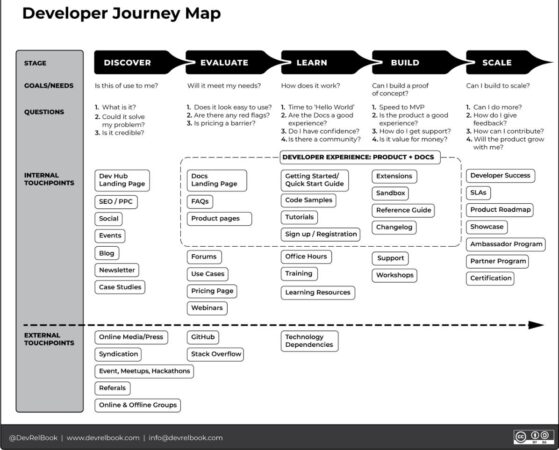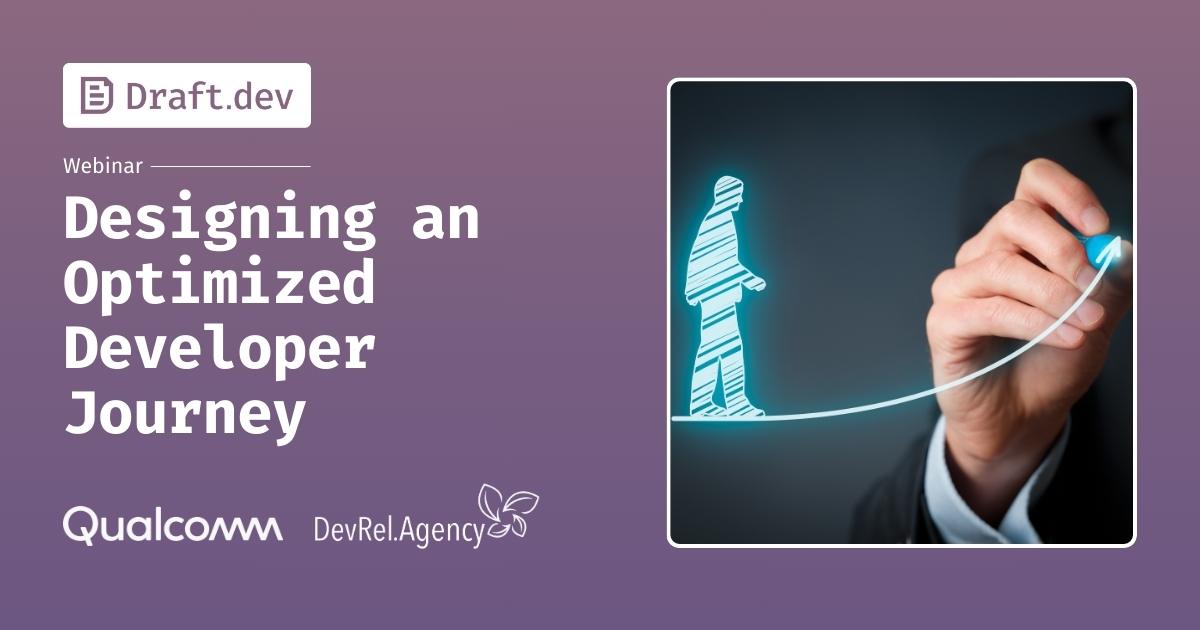In this month’s Draft.dev webinar, we explored the fundamental elements of designing and optimizing developer journeys with experts Caroline Lewko, founder of Devrel.agency, and Morris Novello, head of developer marketing at Qualcomm.
Read on to discover insights on understanding your developers, mapping their journey, optimizing touchpoints, and measuring success.
What Is a Developer Journey?
A developer journey is essentially a roadmap that tracks how developers interact with your product – from initial discovery through adoption and scaling. As Caroline explained:
In terms of the developer journey, it’s being able to understand and track your customer, your user – in our case, the developer.
Morris added a practical perspective, emphasizing that a developer journey should contain:
- Awareness – Making sure developers know about your product
- Reach – Going where developers are
- Adoption – Driving consumption by demonstrating value
The ultimate goal is clear: reducing friction and time-to-market for developers who want to build with your technology. This approach is crucial for any company focused on developer marketing.
Why Developer Journeys Matter
While the importance might seem obvious for dev tool companies, both experts emphasized that all organizations with technical elements should invest in optimizing developer journeys.
Morris explained that the end goal is adoption, and a well-structured journey provides a framework where developers can find everything they need in one place:
Developers—we’ll have an idea in the morning, and then we want to put together a small prototype in the afternoon. We need to have all the elements that we require in one place.
Caroline added that developer journeys become a shared plan for multiple teams, allowing for better alignment between strategies and activities throughout the organization. It enables proper signposting between touchpoints and facilitates tracking and reporting.
Starting Your Developer Journey: Know Your Audience
When building a productive developer journey, our experts agreed that understanding your personas is critical. As Morris emphasized:
It’s about persona, persona, persona. We need to understand what you are building. What is your need? What are your use cases?
Caroline noted the importance of recognizing the diversity among developers:
You might think, ‘Oh, it’s just developers,’ but there’s so many different types of developers in terms of the technologies that they use and the pain points that they need to solve.
Research is essential for identifying these personas. Morris shared that Qualcomm uses various approaches:
- Industry data and research
- Working backwards from use cases
- Internal “dog fooding” with their teams
- External developer advocacy boards

Mapping the Developer Journey
Once you understand your audience, you can map out their journey. Morris outlined his approach:
- Align with business units to understand goals
- Define the strategy based on objectives
- Map the developer journey through discover, evaluate, learn, build, and scale phases
- Implement the journey in a digital representation (developer portal)
Caroline shared a developer journey map that illustrates different touchpoints across these stages. She emphasized that the journey isn’t static: it should evolve based on developer needs and feedback.

Image courtesy of Caroline Lewko, Devrel.agency
Common Mistakes and Pitfalls
Our experts identified several common mistakes to avoid:
- Taking the developer journey for granted
- Assuming developers already understand your technology
- Forgetting developers use multiple tools
- Lack of coordination across teams
Caroline reminded us:
Developers use between 10 and 20 tools to create what they need to do. You’re only part of a developer’s day, so make it easy for them.
Multiple departments often interact with developers, making internal alignment critical. As Caroline noted, someone needs to own the developer journey to ensure proper coordination.
Optimizing Your Developer Journey
After establishing your journey, optimization becomes key. Morris described this as a “continuous improvement, continuous development” approach:
We use data to optimize. We track using this kind of top of the funnel, middle of the funnel, bottom of the funnel approach.
Key metrics Qualcomm monitors include:
- Traffic to developer hub pages
- Time spent on pages
- Social media impressions
- Click-through rates
- Conversion to documentation and sample code
Having clear documentation is essential for this journey—check out our guide on documentation best practices for developer tools to learn more.
Caroline recommended “friction audits” where developers try to build something using your journey while documenting pain points. Common friction areas include:
- Difficulty finding information
- Missing documentation
- Lack of support
- Overly complex processes
Looking Ahead: Future Trends
When asked about future trends, Morris highlighted the importance of developer advocacy and product-led growth:
Embedding the product-led growth type of approach, I call it a developer-led growth approach… capturing the feedback from software contests, from forums, from all these kinds of advocacy mechanisms and embedding this feedback into the developer go-to-market.
This approach aligns perfectly with modern product-led growth strategies for developer tool companies.
Caroline mentioned the value of changing internal metrics to prioritize developer experience:
They started to change the metrics for the engineering and product teams around the developer journey. It’s not just about pushing out ‘I’ve got my JIRA tickets done for the day.
Resource-Constrained Companies
For startups or companies with limited resources, our experts recommend:
- Focus on enabling quick demos – Help developers get up and running fast
- Understand your specific personas – Know exactly who you’re targeting
- Ensure your product is ready for developers – Create basic documentation and quick-start guides before investing in marketing
- Hire senior developer relations talent – Get strategic guidance before focusing solely on advocacy
Balancing Comprehensive Resources
To provide thorough resources without overwhelming developers:
- Use clear signposting – Make the journey steps obvious
- Focus on “how to get started” – Prioritize practical implementation
- Create community support channels – Qualcomm uses Discord to connect developers with subject matter experts
- Develop a strong content architecture – Organize information logically
- Offer multiple content formats – Accommodate different learning preferences with text, diagrams, and videos
- Create workflow-based guides – Help developers follow the right path for their specific needs
Conclusion
Building an optimized developer journey is essential for technical product adoption. By understanding your developers, mapping their journey, avoiding common pitfalls, and continuously optimizing, you can create experiences that reduce friction and accelerate time-to-market.
As our experts made clear, success requires cross-functional alignment, continuous improvement, and a relentless focus on the developer’s perspective. Remember that you’re only part of a developer’s day – make your portion as frictionless as possible.
For companies looking to build stronger developer ecosystems, this journey optimization is a critical foundation. Learn more in our article on strategies for business growth through developer ecosystems.
If you found this post helpful and want to dive deeper into the conversation, you can watch the full webinar here:
Draft.dev’s blog for Technical Content is a great way to learn more about similar DevRel and technical marketing topics.
If you’re interested in driving awareness, capturing leads, and building trust with a technical audience, learn more about our services here.
